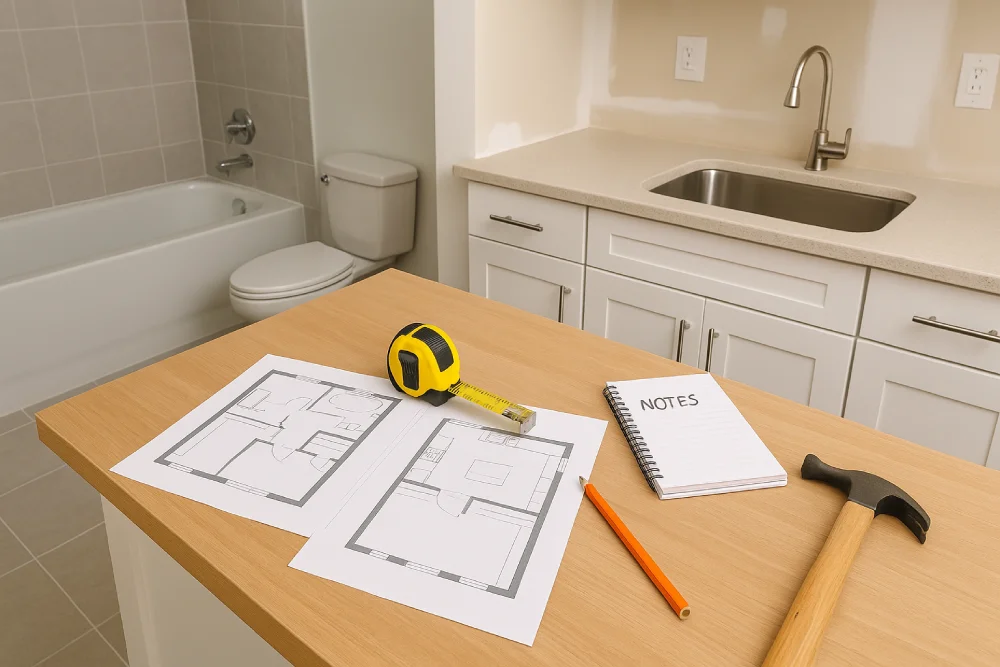
During a kitchen or bath remodel, several phases guide the process. First, homeowners establish goals and budgets. Then, they acquire the necessary permits, guaranteeing compliance with safety codes. After that, demolition occurs, followed by rough-in installation of plumbing and electrical systems. Once the structure is ready, finishing elements like cabinets and tiles are installed. Finally, systems are tested, and a final inspection is conducted. This structured approach safeguards a successful metamorphosis. More viewpoints are just ahead.
Setting clear goals and planning effectively are essential steps in the remodeling process for a kitchen or bath. Homeowners must identify their key reasons for remodeling, such as improving functionality, enhancing aesthetics, or increasing resale value. They should also determine their desired style and layout, weighing prioritizing budget priorities against must-have features. Active homeowner involvement is pivotal during this phase; by considering lifestyle needs, they can guarantee the space will serve them daily. Establishing a clear budget that includes materials, labor, and a contingency fund helps manage expectations and avoids surprises. By researching local costs and exploring multiple budget options, homeowners can align their financial capabilities with their remodeling dreams, ultimately guiding the project toward success. Additionally, understanding the cost breakdown of a bathroom remodel can help homeowners make informed decisions during the planning phase. TriStar’s commitment to craftsmanship ensures that every detail is addressed, leading to a beautifully finished space.
When planning a kitchen or bath remodel, understanding the permitting process is essential for ensuring compliance with local building codes. Acquiring the necessary permits helps prevent costly mistakes while safeguarding the safety and integrity of the home. Recognizing the importance of code compliance allows homeowners to approach their remodeling project with confidence and peace of mind. Additionally, obtaining permits is crucial when making significant structural changes or modifications to the electrical and plumbing systems. Furthermore, working with a reputable contractor can ensure that all aspects of the project, including quality-first approach, are handled professionally and in accordance with regulations.
How can homeowners manage the often complex permit acquisition process for their kitchen or bath remodel? First, they should engage in thorough pre-approval planning by identifying the necessary permits based on their project scope. This includes building, plumbing, electrical, mechanical, and possibly zoning permits for structural changes and installations. Homeowners need to submit detailed application forms and pay related fees, allowing for timeline management throughout the approval process. After submission, the city reviews applications, which can take days to weeks. Scheduling inspections is essential to guarantee compliance with safety and code requirements. By staying organized and proactive, homeowners can traverse this process efficiently, ultimately facilitating a successful remodel. Additionally, it is crucial to consult with the city’s Bureau of Development Services before starting any structural work to ensure compliance with local regulations. Engaging in careful planning can significantly streamline the permit acquisition process and help avoid potential delays.
Understanding the importance of code compliance is essential for anyone planning a kitchen or bath remodel. Adhering to building codes guarantees structural integrity, electrical safety, and plumbing standards, protecting both the homeowner and the community. Compliance with zoning regulations also influences the aesthetics and size of the project, which can affect property values. Additionally, meeting safety standards prevents accidents and enhances durability, yielding financial benefits in the long run. Legal requirements for permits and inspections are pivotal for securing insurance and financing. By prioritizing code compliance, homeowners not only safeguard their investment but also contribute positively to community impact, helping maintain overall safety and property values. Thus, investing time in compliance during pre-construction is priceless.
In the demolition phase of a kitchen or bath remodel, careful planning and execution are essential for a successful outcome. This process involves removing old fixtures and surfaces while implementing effective waste management strategies to ensure responsible and safe handling of debris. A well-organized approach enhances safety and sets the stage for a smooth transition to the next steps of the renovation.
What steps are essential for a successful demolition process during a kitchen or bath remodel? First, thorough planning is indispensable. This includes asbestos testing and lead paint identification to guarantee safety. Next, all items in the space must be removed, and appliances disconnected. Protective coverings should be placed on floors to prevent damage. The area should be sealed off to contain dust.
| Demolition Step | Description |
| Remove Fixtures | Carefully take out sinks and toilets. |
| Tile and Flooring Removal | Use appropriate tools for safe removal. |
| Wall and Ceiling Work | Access utilities by removing structures. |
| Safety Measures | Wear protective gear and ensure proper ventilation. |
Regular cleanup is critical to maintain safety and prepare for the next renovation phase.
Effective waste management strategies play an essential role in the demolition and cleanup phases of a kitchen or bath remodel. By implementing sustainability initiatives, homeowners can significantly reduce their environmental impact. This process begins with sorting waste into categories such as recyclables, hazardous materials, and general trash, using labeled bins on-site for easy disposal. Planning for bin rentals in advance guarantees efficient handling of waste types, minimizing site clutter. Salvaging and donating usable items not only redirects waste from landfills but also supports local charities. Proper recycling practices, including following local guidelines and avoiding contamination, enhance recycling effectiveness. Engaging contractors in these strategies promotes a collaborative effort towards waste reduction, ultimately benefiting both the project and the environment.
Rough-in installation serves as an essential foundation for any kitchen or bath remodel, guaranteeing that plumbing and electrical systems are correctly positioned before finishing touches are added. This phase involves several critical steps, including:
Proper pipe securing methods are crucial to prevent movement and guarantee long-lasting performance. Additionally, coordinating plumbing and electrical placements minimizes conflicts, creating the conditions for a successful remodel. After completing the rough-in stage, inspections are scheduled to confirm compliance with local codes, setting the stage for the next phase of the project.
The installation of finishing elements marks a significant change in any kitchen or bath remodel, as it brings together the various components into a cohesive and functional design. Countertops, often made of durable materials like granite or quartz, are precisely measured and installed using adhesives or mechanical fasteners. Careful seam alignment and sealant application prevent water infiltration, ensuring both beauty and longevity. Backsplashes and wall treatments follow, with tiles set and grouted to create a polished look. Plumbing and electrical fixtures are installed next, ensuring everything operates smoothly. Trim and moldings, including baseboards and crown moldings, are added to cover gaps, followed by edge treatment for a seamless finish. This phase converts the space into an inviting, usable area.
As the remodel nears completion, attention shifts to the final touches that alter the space into a polished and inviting environment. This phase includes a thorough cleaning, final inspections, and the installation of decorative elements. Essential tasks involve:
Additionally, all areas are double-checked for safety and functionality, confirming everything is in working order. The final documentation and handover process includes educating clients on using their new features and collecting feedback for future projects. This attention to detail secures a successful transition from remodel to completed project.
Completing a remodel marks a significant milestone, yet it is essential to address several post-completion considerations to guarantee lasting satisfaction. Homeowners should conduct a thorough walk-through with the contractor to identify any imperfections, verifying cabinetry aligns properly and fixtures function effectively. It’s imperative to test all mechanical systems, including confirming appliance settings for safety and efficiency.
Additionally, warranty registration for installed appliances should be completed to safeguard against future issues. Homeowners must review project documentation, noting maintenance responsibilities and securing contact information for suppliers. Finally, a detailed checklist of completed work will aid in accountability and assure ongoing satisfaction with the newly remodeled space. These steps enhance the overall experience, providing peace of mind and long-term enjoyment.
In summary, a kitchen or bath remodel encompasses several vital phases, from establishing clear goals and obtaining necessary permits to executing final touches and addressing post-completion considerations. Each step plays a critical role in transforming the space in a way that aligns with the homeowner’s vision and practical needs. Understanding this process allows homeowners to prepare effectively for the journey, leading to a smoother experience and a beautifully finished result. With thoughtful planning and skilled execution, you can create a space that enhances both functionality and style.
At TriStar Built, we take pride in being a locally owned and insured construction company in North Texas. Our quality-first approach, combined with strong relationships with long-term subcontractors, ensures that we deliver a client-focused service that you can trust.
A kitchen remodel can take anywhere from a couple of weeks to several months, depending on the type of remodel and scope. A full kitchen remodel with structural changes like new plumbing or electrical work typically takes longer than cosmetic updates to the existing kitchen. Setting a clear kitchen remodel timeline upfront helps avoid delays. After completing your kitchen remodel, optimizing your new space is all about functionality and flow.
The kitchen renovation process includes demolition, layout adjustments, installation of new drywall, plumbing, kitchen cabinetry, new appliances, and finishes like painting and lighting. A step-by-step kitchen remodeling timeline ensures that every step of the process stays on track.
When setting your kitchen remodel budget, account for custom cabinets, hardware, flooring, and labor. Don't forget contingency funds for surprises uncovered in the current kitchen. Planning your kitchen remodel with a realistic budget can prevent overspending and keep your dream kitchen within reach.
When you hire a contractor for your kitchen remodeling project, ensure they are licensed and experienced. A skilled kitchen designer or design-build team can guide you through each step, helping you remodel your kitchen efficiently and in line with your vision.
Yes, but you'll need a temporary kitchen setup. While the kitchen is under construction, having a plan for meals and storage will make the construction phase of your home remodel much smoother. This is especially important for kitchen or bathroom overhauls.
A successful kitchen combines efficiency, flow, and aesthetic appeal. Consider your kitchen layout, lighting, and storage needs. Thoughtfully selected kitchen cabinetry and functional zones for prep, cooking, and cleaning are essential for a new kitchen that feels like a custom kitchen.
Before your project starts, declutter your kitchen and remove any breakables. Prepping the work area ensures contractors can make way for the new elements like new cabinets or custom cabinets, which are often central to a kitchen renovation.
The timeline can vary based on your selections. Choosing quality materials or opting for custom kitchen features can extend lead times. Discuss expectations with your contractor to keep your kitchen remodel timeline manageable and realistic.
The layout of your kitchen—especially if changing—affects how long it’ll take to remodel a kitchen. If your plan includes structural changes like new walls or plumbing, your remodel might extend beyond the average kitchen timeline.
Use a timeline to guide your project, broken into stages like demolition, rough-ins, cabinets are installed, and finishes. Check in throughout the remodel, and communicate often to ensure your kitchen starts looking exactly how you envisioned it.

Whether you’re remodeling a home, expanding a business, or starting from the ground up, TriStar Built is here to guide you every step of the way. With a focus on craftsmanship, communication, and results that last, we make the construction process clear, smooth, and worth every investment.

LOCATION: 2126 James Street, Denton, TX 76205
PHONE: (940) 381-2222
© 2025 TRISTAR BUILT - ALL RIGHTS RESERVED | WEB DESIGN & SEO BY: Authority Solutions®